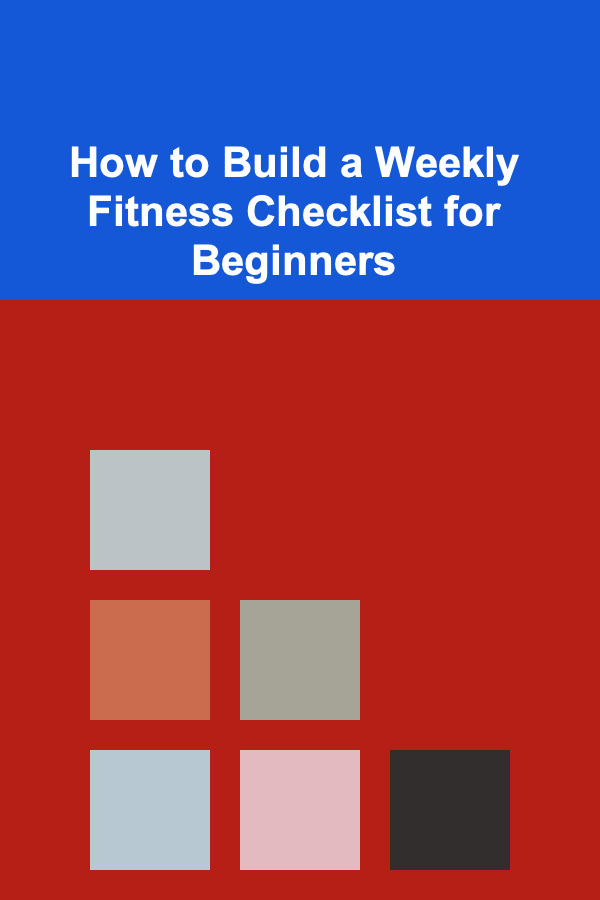
How to Build a Weekly Fitness Checklist for Beginners
ebook include PDF & Audio bundle (Micro Guide)
$12.99$11.99
Limited Time Offer! Order within the next:

Getting started with fitness can be overwhelming, especially when faced with an abundance of exercise programs, diets, and advice from various sources. However, creating a fitness plan that's simple and personalized for beginners can make the journey much easier and more enjoyable. One of the best ways to stay on track is by having a weekly fitness checklist.
A fitness checklist helps beginners structure their weekly workouts, track their progress, and stay motivated. Whether you're aiming to build strength, lose weight, or simply improve your overall health, a well-organized checklist can guide you in achieving your goals step by step.
In this article, we'll explore how to build a weekly fitness checklist, why it's important, and how to structure it to suit your needs as a beginner.
Why You Need a Fitness Checklist
A fitness checklist is essential for beginners because it provides several benefits:
- Organization: It keeps your workout schedule organized, ensuring you know exactly what you need to do each day.
- Consistency: It promotes a consistent workout routine, which is crucial for making progress and building fitness habits.
- Motivation: A checklist helps track your progress and marks small victories. This can keep you motivated and encourage you to keep going.
- Accountability: Having a plan helps you stay accountable. A checklist acts as a visual reminder to complete your workouts, making it less likely you'll skip them.
- Focus on Goals: A checklist helps you focus on your fitness goals and prioritize exercises that align with those goals.
As a beginner, focusing on the basics and not overcomplicating things is key. Your checklist doesn't need to be full of complex or advanced exercises. Instead, it should focus on developing a strong foundation for fitness that includes strength, flexibility, and cardiovascular health.
Step 1: Set Your Fitness Goals
The first step in building a weekly fitness checklist is determining what you want to achieve. Your fitness goals will guide your exercise choices and influence how you structure your workouts. Here are a few common fitness goals:
- Weight loss: This goal focuses on burning fat and achieving a healthier body composition.
- Muscle building: If you aim to increase strength and muscle mass, your workouts will focus on resistance training.
- Endurance and cardio fitness: For those looking to improve cardiovascular health and stamina, aerobic exercises like running, cycling, or swimming are important.
- General health and wellness: Many beginners simply want to feel healthier and more active. In this case, a well-rounded fitness plan is appropriate.
- Flexibility and mobility: For those focusing on flexibility or reducing stiffness, activities like yoga or Pilates are beneficial.
After identifying your primary goal, you can design a fitness plan that aligns with that objective. Remember, goals should be SMART (Specific, Measurable, Achievable, Relevant, Time-bound), which will help you track progress and stay focused.
Step 2: Understand the Components of a Balanced Fitness Plan
A well-rounded fitness plan should incorporate various types of exercise to ensure you're addressing all aspects of fitness. For beginners, the following components are essential:
1. Cardiovascular Exercise
Cardio exercises help increase heart rate, improve lung capacity, and burn calories. Cardiovascular health is vital for overall well-being and forms the foundation of any fitness routine.
- Examples: Walking, jogging, cycling, swimming, jump rope, and dancing.
- Frequency: At least 3--4 times per week.
- Duration: 20--30 minutes for beginners.
2. Strength Training
Strength training builds muscle mass, increases metabolism, and improves bone density. For beginners, bodyweight exercises are great, as they don't require any equipment.
- Examples: Squats, lunges, push-ups, planks, dumbbell exercises, and resistance band exercises.
- Frequency: 2--3 times per week (with at least one day of rest between sessions).
- Duration: 20--30 minutes per session.
3. Flexibility and Mobility
Stretching and mobility exercises increase flexibility, prevent injury, and improve posture. Incorporating flexibility exercises into your routine helps maintain balance in your fitness journey.
- Examples: Yoga, Pilates, dynamic stretches, and static stretches.
- Frequency: 2--3 times per week.
- Duration: 15--20 minutes per session.
4. Rest and Recovery
Rest is often overlooked but is crucial for muscle recovery and preventing burnout. Adequate sleep and rest days allow your muscles to repair and grow stronger.
- Frequency: 1--2 rest days per week.
- Duration: Ensure 7--9 hours of sleep each night.
Step 3: Design Your Weekly Workout Schedule
Now that you have a solid understanding of the components of a fitness plan, it's time to structure your weekly schedule. Beginners should focus on consistency and progression, aiming to gradually increase intensity and volume.
Sample Weekly Fitness Plan for Beginners
Here's an example of a balanced fitness schedule for beginners that includes cardio, strength training, and flexibility exercises:
Monday: Full Body Strength Training
- Warm-up: 5--10 minutes of light cardio (jogging, cycling, or brisk walking).
- Exercises:
- Squats (3 sets of 12--15 reps)
- Push-ups (3 sets of 8--12 reps)
- Bent-over rows (3 sets of 12 reps)
- Planks (3 sets, hold for 30 seconds)
- Cool-down: 5--10 minutes of stretching.
Tuesday: Cardio
- 30 minutes of steady-state cardio, such as walking, jogging, or cycling.
- Cool-down: 5 minutes of stretching.
Wednesday: Flexibility and Mobility
- 30 minutes of yoga or a full-body stretching routine focusing on flexibility.
- Incorporate deep breathing and mindfulness during the session.
Thursday: Lower Body Strength Training
- Warm-up: 5--10 minutes of light cardio.
- Exercises:
- Lunges (3 sets of 12 reps per leg)
- Glute bridges (3 sets of 15 reps)
- Leg raises (3 sets of 15 reps)
- Side planks (3 sets, hold for 30 seconds each side)
- Cool-down: 5--10 minutes of stretching.
Friday: Cardio + Core
- 20--30 minutes of moderate-intensity cardio (e.g., brisk walking, cycling).
- Core exercises:
- Bicycle crunches (3 sets of 15 reps)
- Russian twists (3 sets of 15 reps per side)
- Leg raises (3 sets of 15 reps)
Saturday: Full Body Strength Training
- Similar to Monday's workout but include variations in exercises (e.g., swap squats for deadlifts or push-ups for chest presses).
Sunday: Rest or Active Recovery
- Rest day or active recovery like walking or light stretching.
This weekly schedule strikes a balance between cardio, strength training, flexibility, and recovery. For beginners, it's important to start slow and gradually increase intensity as you become more comfortable with the exercises.
Step 4: Track Your Progress
Tracking your progress is crucial for staying motivated and measuring the effectiveness of your fitness plan. You can track your workouts in a variety of ways:
- Fitness App: Many apps allow you to log workouts, track progress, and set goals.
- Notebook or Journal: Keep a fitness journal where you record exercises, sets, reps, and how you felt during the workout.
- Body Measurements and Weight: Track changes in your body measurements, weight, and how your clothes fit to monitor progress.
- Fitness Tests: Periodically perform fitness tests (e.g., push-up test, 5-minute walk test) to assess your strength, stamina, and flexibility.
Step 5: Stay Consistent and Adjust
Consistency is key when it comes to fitness. It's normal to experience some ups and downs, but as long as you stick to your routine and stay focused on your goals, you will see progress. Don't be afraid to make adjustments to your checklist if something isn't working. If you find certain exercises too challenging, reduce the intensity or try beginner variations.
Additionally, as you improve, you can gradually increase the difficulty of your workouts. Add more weight, try more advanced exercises, or increase the duration of your cardio sessions. These small adjustments will help prevent plateaus and keep your fitness journey exciting.
Conclusion
Building a weekly fitness checklist as a beginner is a powerful tool for achieving your fitness goals. By setting clear goals, understanding the key components of fitness, designing a balanced workout schedule, tracking your progress, and staying consistent, you'll be well on your way to developing lasting fitness habits.
Remember, fitness is a journey, not a destination. Stay patient with yourself, celebrate small victories, and, most importantly, enjoy the process of becoming a healthier and stronger version of yourself.
Reading More From Our Other Websites
- [Personal Care Tips 101] How to Use Sunscreen with Makeup
- [Home Lighting 101] How to Choose the Best Light Bulbs for Every Room
- [Sewing Tip 101] The Ultimate Guide to Choosing the Right Notions for Different Fabrics
- [Rock Climbing Tip 101] The Ultimate Guide to Choosing the Perfect Rock Climbing Holds for Every Skill Level
- [Screen Printing Tip 101] Troubleshooting Common Cricut Screen-Printing Issues and How to Fix Them
- [Home Pet Care 101] How to Train Your Cat to Use a Scratching Post
- [Personal Finance Management 101] How to Analyze Your Spending Habits for Improvement
- [Personal Investment 101] How to Apply Best Long-Term Investment Strategies When Building a Diverse Portfolio
- [Personal Finance Management 101] How to Negotiate Bills and Lower Your Monthly Expenses
- [Home Party Planning 101] How to Prepare for a Home Party with Children in Attendance

How to Soundproof a Room with Minimal Disruption
Read More
How to Stage a Living Room to Appeal to Buyers
Read More
How to Understand the Global Renewable Energy Market
Read More
How to Use Trays for Grouping Similar Items Together
Read More
10 Tips for Interpreting Seismic Data in Petroleum Engineering
Read More
10 Tips for Athletes: Optimizing Performance with Chiropractic
Read MoreOther Products

How to Soundproof a Room with Minimal Disruption
Read More
How to Stage a Living Room to Appeal to Buyers
Read More
How to Understand the Global Renewable Energy Market
Read More
How to Use Trays for Grouping Similar Items Together
Read More
10 Tips for Interpreting Seismic Data in Petroleum Engineering
Read More